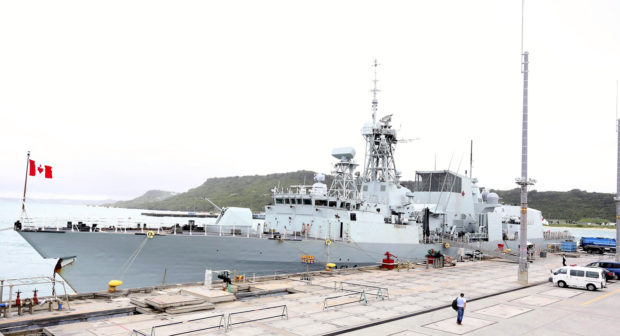
The Canadian frigate Regina docks at U.S. Naval Base White Beach in Uruma, Okinawa Prefecture, on June 26. The Japan News/Asia News Network
TOKYO — North Korea’s open-sea transfers of petroleum products to its ships in the East China Sea and elsewhere are getting more scrutiny from Japan and six other nations.
Yet even as Japan, the United States, Britain, Australia, France, Canada and New Zealand work more closely together, the ship-to-ship transfers are getting more shrewd.
On June 26 while the Canadian patrol frigate Regina was docked at U.S. Naval Base White Beach in Okinawa Prefecture, the ship’s commanding officer, Cmdr. Jacob French, 42, told The Yomiuri Shimbun — in a rare interview of a commander describing field operations — about having to give up pursuit of a vessel when it approached China’s territorial waters.
The Regina, which sailed from the Taiwan Strait to Okinawa, conducted patrols in the high seas of the East China Sea from June 17 to 25. Twice in its first 24 hours it encountered what French suspects was open-sea smuggling, such as ships coming alongside each other at sea.
The frigate carried out patrols into the night and a ship-based helicopter was dispatched to take photographs.
French said open-sea smuggling often takes place in waters off Shanghai or near North or South Korea. The evidence the patrols gather is shared with intelligence agencies.
The Canadian military also surveils the East China Sea from the air via CP-140 patrol planes flying out of the U.S. Air Force’s Kadena Air Base, also in Okinawa Prefecture. Canadian Capt. Hugues Canuel, 50, said they track boats that engage in suspicious behavior, such as those that rush to put hoses away or ones that lower their flags.
Seven-nation effort
The Self-Defense Forces and U.S. military began the patrols at the end of 2017. In 2018, they were joined in April by Australia and Canada, in May by Britain and in September by New Zealand. France joined in from this March.
The seven nations have settled into a pattern in which Japan and the United States are constantly conducting operations, with the other nations joining for several weeks at a time, heading home, then coming back. South Korea apparently also monitors waters close to the Korean Peninsula.
According to sources, there is a coordination center on the U.S. amphibious command ship Blue Ridge of the 7th Fleet based at U.S. Naval Base Yokosuka in Kanagawa Prefecture. The participating countries’ information-sharing on the movements of North Korean vessels based on satellite imagery and other information as well as division up patrol areas is coordinated from the center.
The so-called Five Eyes nations — the five English-speaking countries of the United States, Britain, Canada, Australia and New Zealand — gather intelligence and share classified military information. Some in the Japanese government hope that working with these five nations will provide a foothold toward deeper cooperation.
Using waters off China
The SDF have observed 20 instances of what it believes were open-sea smuggling in the East China Sea. Ships that appeared to be fueling North Korean tankers have displayed Chinese place names and characters showing them to be fuel transport vessels.
Yet monitoring is gradually becoming more difficult. While initially the open-sea transfers took place in the middle of the East China Sea, the sites have been moving southward and closer to the Chinese mainland. Numerous cases near the Chinese coast have been confirmed since the latter half of last year.
Increasingly, North Korean tankers are fleeing to Chinese territorial waters, a senior SDF officer said.
SDF intelligence-gathering aircraft that monitor boat movements have had to turn back after being approached by Chinese military fighters, government sources said.
In the midst of this situation, the Canadian frigate Regina passed through the Taiwan Strait, a sensitive area for China. Reuters reported that a French military vessel also passed through the strait in April to begin surveillance activities there.
“Applying pressure to urge China to help the crackdown is another aspect for the cooperation among these countries,” another senior SDF officer said.